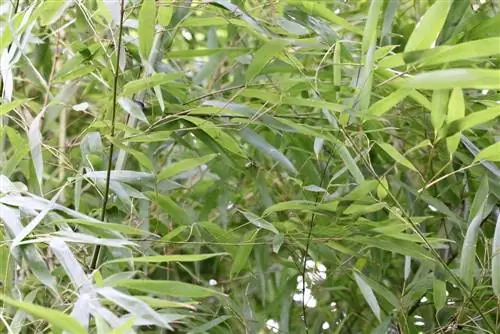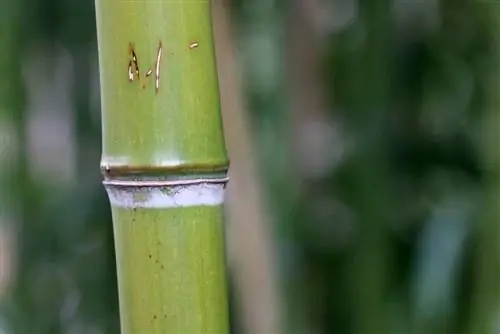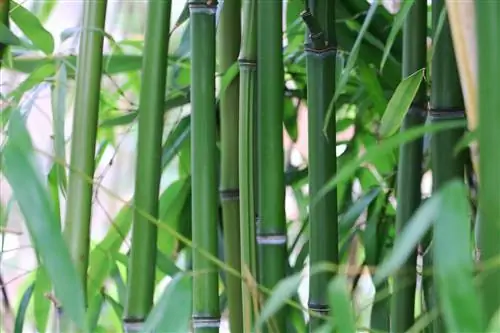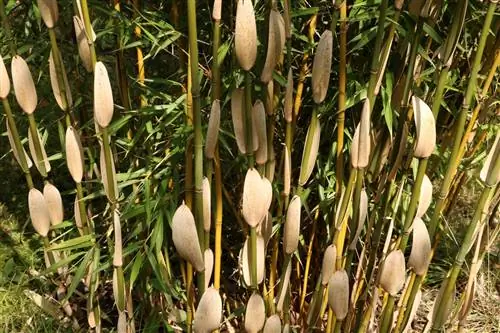- Author admin [email protected].
- Public 2023-12-17 03:39.
- Last modified 2025-06-01 06:48.
Characteristic of this type of bamboo is its evergreen and mostly upright growth, whereby the upper area can hang down slightly. Planting as a privacy screen or hedge is therefore very popular among hobby gardeners, as the plant growth is very opaque. If you look at the umbrella bamboo in its native East Asia, the plants there can grow up to 6 meters tall, which no gardener in this country wants. That's why the trade has specialized in varieties that have a height of 1.5 to 3 meters suitable for garden use. With the right pruning, the bamboo can quickly be kept at an individual height so that it doesn't grow too much.
Features of umbrella bamboo
- Growth: upright and broadly bushy
- Size: 1.5 to 3 m
- Leaves: dark green and elongated, evergreen
- Location: sunny - partially shaded, sheltered from the wind
- Soil: humic and permeable
- hardy down to -24°C
- loves high humidity
- Planting time: February to November
- fast growing
- Use: hedge, potted plant, privacy screen, individual stand
Advantages of umbrella bamboo
The umbrella bamboo can be used in many different ways in our gardens. Either as a densely planted hedge for privacy or in larger pots that can be beautifully placed on a terrace. There are no limits to the variety of ideas here, as the beautiful green of the leaves is a feast for the eyes everywhere. In addition, the winter-hardy aspect is particularly advantageous when building hedges, as you don't have to worry about your bamboo on frosty winter days. As long as the temperatures do not drop below -24°C, everything is fine, otherwise special precautions must be taken to preserve the beauty of the plant. Otherwise, the bamboo also scores points for its rapid growth and the rather low formation of runners (branches), so that they look very good as a hedge or in pots.
However, so that you can enjoy the umbrella bamboo for years to come, you should definitely make sure that it is not exposed to permanent sun, but is assigned a partially shaded place in the garden. In addition, the plant's water balance must not be neglected, which means that the umbrella bamboo needs to be watered regularly, especially in the winter months. If you don't stick to this, the once wonderful bamboo can quickly lose its color, which ultimately leads to the umbrella bamboo shrinking.
Location
Every type of umbrella bamboo loves a partially shaded to sunny spot where it can thrive beautifully. The soil should be nutrient-rich, humus-rich and permeable so that the roots can absorb sufficient moisture. That's why bamboo prefers small front, gravel or Japanese gardens, although forest gardens or prairie plantings are also used. The most beautiful location for any type of bamboo is in direct proximity to a garden pond or stream, as the humid location is an optimal breeding ground for the bamboo.
Planting umbrella bamboo correctly
Once you have decided to have an umbrella bamboo in your garden, all you need to do is plant it properly and look after it over the years. When digging the planting pit, it should be noted that it should be twice as large as the actual root ball. The inside of the pit is then loosened up slightly so that excess water can drain away quickly. Now place the bamboo in the hole as deep as it was previously grown in the culture pot and fill the planting pit again with garden soil.
A watering wall is then built around the umbrella bamboo, which is followed by heavy watering of the plant. This gives the bamboo the moisture it urgently needs to grow and supposed cavities in the earthwork are also closed again. With weather-oriented watering you can now complete your work and let the bamboo thrive beautifully.

Fertilize
The umbrella bamboo is known for requiring a lot of nutrients in order to grow perfectly. It is therefore advisable to supply it with seasoned cattle dung and horn shavings in spring (March) and summer (June / July). If you have no way of accessing cattle manure, you can also use a nitrogen-rich complete fertilizer as an alternative. As a natural mulch, you can also leave the dead leaves at the base of the plant so that the moisture stays in the soil longer and the umbrella bamboo can be supplied with nutrients.
pruning
Basically, you don't need to cut back an umbrella bamboo to rejuvenate it. Only the height desired by the owner is decisive for whether pruning is necessary for shortening or not. However, if you have a lot of individual plants in the garden, you can branch the front stalks in the lower area, which creates visual depth.
Depending on how hard the winter was, individual frost damage may also become visible. Brown leaves or dried shoots are removed in spring by cutting off the affected shoots close to the ground. However, whether the bamboo will sprout again at the location in question remains a pure gamble that cannot be influenced. As a preventative measure, reed mats can only be tied around the bamboo to provide additional protection.
What you should know about umbrella bamboo in brief
The umbrella bamboo is an evergreen plant with a wide range of uses. However, one should not underestimate the fact that the bamboo can dry out if there is not enough moisture and needs to be watered regularly even in winter. If it is planted directly in the garden, it can overwinter without any problems, but planting it in pots should be carefully considered beforehand. Because as a potted plant, the umbrella bamboo can only overwinter at a room temperature of +1 to +10°C without it being damaged.
- The special thing about umbrella bamboo is that it does not spread as uncontrollably as many of its conspecifics. It is a clump-forming species. It therefore does not require a root or rhizome barrier. It is also evergreen, which is another advantage.
- Otherwise, the upright growing bamboo is quite easy to care for. It is frost hardy, even in cold regions. The umbrella bamboo grows very bushy and looks good on its own, even in a pot.
- If you have enough space, you can also use it as a hedge plant and privacy screen. The plants grow two to three meters high and are very dense.
- The location can be chosen sunny, but also partially shaded. In some cases it can also tolerate deep shade as long as it is bright enough there.
- On the other hand, he doesn't like full midday sun that much. Extreme heat and drought are not his thing either. A partially shaded location is better.
- Since the umbrella bamboo is sensitive to icy winds, it should not be planted where it is exposed to them.
- It has few demands on the floor. All good garden soil is suitable if it is fresh to moist. Bamboo needs enough water, otherwise it will dry out.
- You use slow-release fertilizer as fertilizer, then it is enough to fertilize it once a year.
In recent years, the bamboo variety has bloomed twice in a row, worldwide. With bamboo, this is a phenomenon that actually only occurs every 80 to 100 years. After flowering, the plants die. There are now enough plants again, but many have been modified through breeding. Laboratory plants do not always have the same properties as naturally propagated ones. You should therefore seek advice when purchasing.






